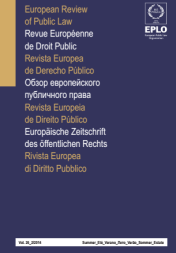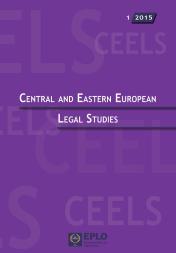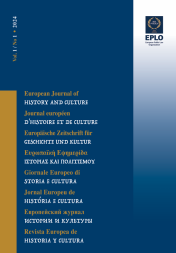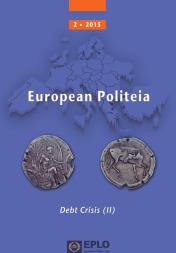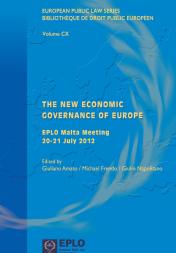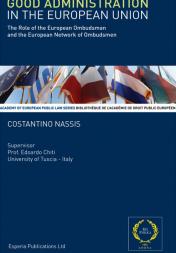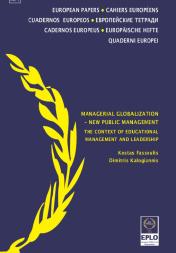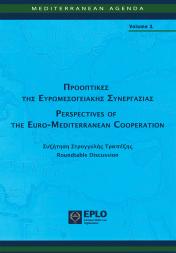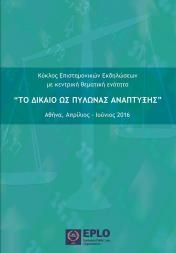Submissions
General Guidelines for Submissions to the EPLO Publications
All potential conflicts of interest must be disclosed on the title page of the manuscript. To avoid any conflict of interest, authors should state their present affiliation and indicate any personal or professional involvement in the subject matter of their manuscript as well as any funding of their research.
Submission of a manuscript will be held to imply that the work described contains original material that has been approved by all co-authors and is not under consideration for any other publication at the same time.
If the manuscript, or any other version of it (including in another language), is under consideration by another publication / has been or will be published elsewhere / is available at a repository or pre-print server, authors are required to state this at the time of submission. If a preprint of the manuscript is available at a pre-print server / repository, the exact citation must be included in the submission.
Once material has been accepted for first publication by the EPLO, it should not be submitted for publication elsewhere, either in print or electronic form, without the consent of the Editors/Publisher.
No proofs are submitted to the authors before publication unless explicitly required upon submission of the manuscript or if deemed necessary by the EPLO Publications Editing Secretariat.
In order to attract scholarship of the highest standard, papers submitted by authors undergo rigorous peer review. The process of review normally takes between six to eight weeks.
General Policies and Information
The content of the manuscripts engages only their authors and in no case the EPLO Publications or the EPLO.
Copyright in all pieces accepted for publication remains with the Publisher, unless otherwise explicitly requested by the Author. lf all or any part of a manuscript is reproduced elsewhere upon prior written permission by the Publisher, the Author should refer to its original place of publication (Journal or any other EPLO Publication). All rights reserved. No part of the EPLO Publications may be reproduced in any form, by any electronic or mechanical means, including information storage and retrieval system without written permission from the Publisher.
Formatting Standards
This is not intended to be a comprehensive guide to our house style and formatting guidelines but it does offer a few key points that we would appreciate if respected. However, authors are kindly requested to note that their texts will be edited thoroughly for house style points by the EPLO Publications Editing Secretariat. Please refer also to the guidelines (1. Submissions and 2. Formatting Styles) under each EPLO journal below for more specific guidelines pertaining to each journal.
General
Manuscripts should be submitted in Word format (Times New Roman font, size 11, text justified). Paragraphs should not be indented. Please use footnotes rather than endnotes, using Times New Roman font, size 10.
The text should start with the title of the article which is to be followed by the author’s name. The full first name of the author should be used (not only the initial) and a footnote marked with an asterisk (*) should refer to the author’s institutional affiliation (e.g. Professor at the University of Paris I).
If there are more than one author, then the names should be separated by slashes (/), and separate asterisk footnotes (e.g. * for the first author, ** for the second author etc.) should be used referring to their institutional affiliation (see point above).
If authors wish to present acknowledgements, disclaimers or other text of this kind, they are requested to insert an asterisk (*) footnote to the title of the article. In this case, the footnote to the author’s name referring to his/her affiliation (see points above) should be a double asterisk (**) footnote.
Cross-references should refer to the relevant section of the article or to the exact footnote number and not to a page number of the article.
All references, cross-references and citations should be checked by the authors before the submission of their articles.
Final decisions on formatting matters, or matters of grammar, punctuation etc. that are not mentioned in this document are to be taken by the Editors.
____________________________________________________________________________________________
Submitting Your Manuscript
Manuscripts should be submitted by email to submissions@eplopublications.eu.
Please indicate the journal to which your manuscript is being submitted
in the subject line of your email, for example: “Submission to the European Review of Public Law”.
____________________________________________________________________________________________
1. Submissions
Articles should not normally exceed 12,000 words including footnotes. They should begin with an indented and italicised abstract of around 150 words which sets out the main arguments and conclusions of the article.
The ERPL is committed to linguistic diversity by accepting submissions in seven languages: English, French, Spanish, Russian, Portuguese, German and Italian. If the article is written in a language other than English, then an abstract and title in English should be submitted as well. 3-4 keywords in English for indexing purposes should accompany the paper. If the article is written in a language other than English, an abstract, the title of the article, and 3-4 keywords (in the language of the article and in English) should accompany the paper. Authors’ names and affiliations as well as Bibliographical References should be in Roman script (or also in Roman script) in case of papers written in non-Roman script.
Shorter articles dealing with developments in recent legislation and case-law within the European institutions for the on-line edition of the European Review of Public Law should usually be in the vicinity of 1,500-3,000 words.
Book reviews should normally be of 1,000-2,000 words in length. Expressions of interest for specific book reviews or suggestions of books to be reviewed should be communicated in advance to the Book Review editor. Reviews are also considered from the review books sent to us by publishers. Contributions and proposals regarding literature of non-English publications are particularly encouraged. In order to ensure the widest possible readership of the review information about these publications, submissions for book reviews are accepted in English or French only.
Authors are requested to use the house style and formatting guidelines.
2. Formatting Styles
- Bolds or underlining are not used according to the ERPL formatting styles. If the author wishes to emphasize, he/she should use italics.
- Italics should be used for the following (italics are not used for the following cases when the relevant words or phrases are part of a wider sentence in italics):
- The names of cases (e.g. affaire Dubreuil, Kherouaa case etc.)
- Short phrases or individual words using another language than the one in which the article is written (e.g. Conseil d’Etat when the article is not written in French but in one of the other official languages of the ERPL)
- Common Latin abbreviations or words (e.g., i.e., cf., ad hoc, per se, ibid., etc.)
- Special emphasis should be given to the formatting of the footnotes:
- The names of the authors mentioned in the footnotes should not be written in capital letters (All Caps). According to the ERPL formatting standards, the author names are presented in Small Caps. However, if this is not possible, please use regular letters (e.g. or Aster Veldkamp). In case there are two or more authors, please separate their names with a slash (/). In case there are more than three authors, the name of the first author can be used followed by: et al.
- The titles of books are italicised.
- The titles of articles are regular and they should not be between inverted commas.
- The titles of periodicals are italicised (even their abbreviated titles).
- Abbreviated Law Reports are not italicised.
- If a reference is made to an article in a book, this should be made as follows: author, title of the article, in: editor, book title, etc.
- The footnote numbers should be placed before the punctuation mark. Endnotes should not be used.
- Footnoting should not be excessive.
- Hyphens used as a punctuation device should be short, with a space either side.
- It is advisable that when acronyms or abbreviations are used, items are spelt out in full when first appearing (e.g. European Convention on Human Rights (ECHR) or (hereinafter ECHR)).
- Website addresses should not be bold or underlined.
1. Submissions
Articles should not normally exceed 12,000 words including footnotes. They should begin with an indented and italicised abstract of around 150 words which sets out the main arguments and conclusions of the article.
The CEELS accepts articles in English, French, Russian, German, Italian as well as in the native languages of authors coming from Central and Eastern European countries (including the Turkish and Greek languages). If the article is written in a language other than English, then an abstract and title in English should be submitted as well. 3-4 keywords in English for indexing purposes should accompany the paper. If the article is written in a language other than English, an abstract, the title of the article, and 3-4 keywords (in the language of the article and in English) should accompany the paper. Authors’ names and affiliations as well as Bibliographical References should be in Roman script (or also in Roman script) in case of papers written in non-Roman script.
Authors are requested to use the house style and formatting guidelines.
2. Formatting Styles
- Bolds or underlining are not used according to the CEELS formatting styles. If the author wishes to emphasize, he/she should use italics.
- Italics should be used for the following (italics are not used for the following cases when the relevant words or phrases are part of a wider sentence in italics):
- The names of cases (e.g. affaire Dubreuil, Kherouaa case etc.)
- Short phrases or individual words using another language than the one in which the article is written (e.g. Conseil d’Etat when the article is not written in French but in one of the other official languages of the ERPL)
- Common Latin abbreviations or words (e.g., i.e., cf., ad hoc, per se, ibid., etc.)
- Special emphasis should be given to the formatting of the footnotes:
- The names of the authors mentioned in the footnotes should not be written in capital letters (All Caps). According to the CEELS formatting standards, the author names are presented in Small Caps. However, if this is not possible, please use regular letters (e.g. or Aster Veldkamp). In case there are two or more authors, please separate their names with a slash (/). In case there are more than three authors, the name of the first author can be used followed by: et al.
- The titles of books are italicised.
- The titles of articles are regular and they should not be between inverted commas.
- The titles of periodicals are italicised (even their abbreviated titles).
- Abbreviated Law Reports are not italicised.
- If a reference is made to an article in a book, this should be made as follows: author, title of the article, in: editor, book title, etc.
- The footnote numbers should be placed before the punctuation mark. Endnotes should not be used.
- Footnoting should not be excessive.
- Hyphens used as a punctuation device should be short, with a space either side.
- It is advisable that when acronyms or abbreviations are used, items are spelt out in full when first appearing (e.g. European Convention on Human Rights (ECHR) or (hereinafter ECHR)).
- Website addresses should not be bold or underlined.
1. Submissions
In order to attract scholarship of the highest standard, papers submitted by authors undergo rigorous peer review. The process of review normally takes between six to eight weeks.
Articles should not normally exceed 12,000 words including footnotes. They should begin with an indented and italicised abstract in English (of around 200 words) which sets out the main arguments and conclusions of the article. 4-5 keywords in the language in which the paper is written and in English should accompany the paper for indexing purposes. The author may also submit up to 8 images (black & white or colored, in jpeg format).
2. Formatting Styles
The European Journal of History and Culture is committed to linguistic diversity by accepting submissions in eight languages: English, French, German, Greek, Italian, Portuguese, Russian and Spanish. If the article is written in a language other than English, its title should be provided in English as well. Authors’ names and affiliations should also be in Roman script in case of papers written in non-Roman script. Bibliographical References in the Cyrillic script shall be accompanied by the respective References in Roman script between brackets.
- The texts should be presented in Times New Roman font, size 11, text justified. Paragraphs should not be indented. Please use footnotes rather than endnotes, using Times New Roman font, size 10.
- The text should start with the title of the article which is to be followed by the author’s name. The full first name of the author should be used (not only the initial) and a footnote marked with an asterisk (*) should refer to the author’s institutional affiliation (e.g. Professor at the University of Paris I).
- If there are more than one author, then the names should be separated by slashes (/), and separate asterisk footnotes (e.g. * for the first author, ** for the second author etc.) should be used referring to their institutional affiliation (see point above).
- If authors wish to present acknowledgements, disclaimers or other text of this kind, they are requested to insert an asterisk (*) footnote to the title of the article. In this case, the footnote to the author’s name referring to his/her affiliation (see points above) should be a double asterisk (**) footnote.
- Cross-references should refer to the relevant section of the article or to the exact footnote number and not to a page number of the article.
- All references, cross-references and citations should be checked by the authors before the submission of their articles.
Authors who wish to publish archival documents are requested to use the following guidelines:
- The date and the place of writing the document should be presented in Times New Roman font, size 11, text align right.
- A small abstract of the document (2-3 lines) should be presented in Times New Roman font, size 11, text justified.
- The archival reference should be presented in Times New Roman font, size 10, text justified.
- The texts of the published archival documents should be presented in Times New Roman font, size 11, italicised, text justified.
Authors are requested to use the house style and formatting guidelines.
- Bolds or underlining are not used according to the European Journal of History and Culture formatting styles. If the author wishes to emphasize, he/she should use italics.
- Italics should be used for the following (italics are not used for the following cases when the relevant words or phrases are part of a wider sentence in italics):
- Short phrases or individual words using another language than the one in which the article is written
- Common Latin abbreviations or words (e.g., i.e., cf., ad hoc, per se, ibid., etc.)
- Special emphasis should be given to the formatting of the footnotes:
- The names of the authors / editors mentioned in the footnotes should not be written in capital letters (All Caps). According to the European Journal of History and Culture formatting standards, the author / editor(s) names are presented in Small Caps. However, if this is not possible, please use regular letters (e.g. Aster Veldkamp). In case there are two or more authors / editors, please separate their names with a slash (/). In case there are more than three authors / editors, the name of the first author can be used followed by: et al.
- The titles of books are italicised.
St. Runciman, The Eastern Schism, Oxford 1955, pp. 78-170
Italian Etchers of the Renaissance & Baroque, Exhibition Catalogue (Boston, Museum of Fine Arts - Cleveland, The Cleveland Museum of Art – Washington D. C., National Gallery of Art), ed. S. Welsh Reed / R. Wallace, Boston 1989, pp. 85-88
M. Tziatzi-Papagianni (ed.), Theodori Metropolitae Cyzici Epistulae. Accedunt epistulae mutuae Costantini Porphyrogeniti, [Corpus Fontium Historiae Byzantinae - Series Berolinensis 48], Berlin-Boston 2012, p. 212
- The titles of articles are regular and they should not be between inverted commas.
D. M. Nicol, The Byzantine View of Western Europe, Greek, Roman and Byzantine Studies 8 (1967), 315-339
- The titles of periodicals are italicised (even their abbreviated titles).
- If a reference is made to an article in a book, this should be made as follows: author, title of the article, in: editor, book title, etc.
T. M. Kolbaba, Byzantine Perceptions of Latin Religious ‘Errors’: Themes and Changes from 850 to 1350, in:A. E. Laiou / R. Parviz Mottahedeh (eds.), The Crusades from the Perspective of Byzantium and the Muslim World, Washington DC 2001, pp. 117-143
- Website addresses should not be bold or underlined.
http://ec.europa.eu/sport/library/documents/b24/xg-gg-201307-dlvrbl2-sep...
(last visited 22 Oct. 2013).
- The footnote numbers should be placed before the punctuation mark. Endnotes should not be used.
- Footnoting should not be excessive.
- It is advisable that when acronyms or abbreviations are used, items are spelt out in full when first appearing (e.g. Archivio di Stato di Venezia (ASV) or (hereinafter ASV).
Archivio di Stato di Venezia (ASV), Senato, Dispacci dei provveditori da Terra e da Mar (PTM), filza 1003, f. 3v (12 maggio 1797)
Final decisions on formatting matters, or matters of grammar, punctuation etc. that are not mentioned in this document are to be taken by the Editors.
Submission Guidelines (EN)
General
Submission of a manuscript will be held to imply that the work described contains unpublished, original material that has been approved by all co-authors and is not under consideration for any other publication at the same time.
Articles submitted for publication undergo rigorous peer review. The process of review normally takes between six to eight weeks.
The review decision will be either acceptance, acceptance subject to proposed changes, or rejection.
If the manuscript is accepted for publication, the material should not be submitted for publication in any other medium without the consent of the Publisher/Editors.
No proofs will be sent to authors prior to publication unless the Editorial Board deems it necessary.
To avoid any conflict of interest, authors should state their present affiliation and indicate any personal or professional involvement in the subject matter of their manuscript as well as any funding of the research.
General Policies and Information
The content of the manuscripts engages only their authors and in no case the EPLO Publications, the EPLO or the Capítulo Mexicano of the EPLO.
Copyright in all pieces accepted for publication remains with the Publisher, unless otherwise explicitly requested by the Author.
If all or any part of a manuscript is reproduced elsewhere upon prior written permission by the Publisher/Editors, the author must make reference to its original place of publication in the Latin American Public Law Review.
No part of this publication may be reproduced in any form, by any electronic or mechanical means, including information storage and retrieval system without written permission from the Publisher/Editor.
- 1. Submissions
The Latin American Public Law Review is committed to linguistic diversity by accepting submissions in: English, French, German, Italian, Portuguese and Spanish.
Shorter articles dealing with developments in recent legislation and case-law within the Latin American institutions should usually be in the vicinity of 1,500-3,000 words.
Book reviews should normally be of 1,000-2,000 words in length.
Authors are requested to use the house style and formatting guidelines.
Articles:
- should not normally exceed 12,000 words including footnotes
- Should begin with an indented and italicized abstract (of around 150 words) in the original language of the submission, which sets out the main arguments and conclusions of the article. The abstract should additionally be in English for articles written in another language, at the author’s discretion. This requirement does not apply to Book Reviews.
- should be accompanied by 3-4 keywords in the original language of the submission and in case the text is written in one of the other languages in which submissions are accepted in the Latin American Public Law Review, the keywords should also be in English. This requirement does not apply to Book Reviews.
The title of the article should additionally be provided in English, in case the text is written in one of the other languages in which submissions are accepted in the Latin American Public Law Review.
Authors’ names and affiliations as well as bibliographic references should be in Roman script.
Manuscripts should be linguistically revised before their submission.
Submissions or any questions with regard to submissions are to be sent to the EPLO Editions Office.
- 2. Formatting Guidelines
Formatting Guidelines
Authors are kindly requested to note that their texts will be edited thoroughly for house style points by the EPLO Publications Editing Secretariat.
- Manuscripts should be submitted in Word format (Times New Roman font, size 11, text justified). Paragraphs should not be indented. Please use footnotes rather than endnotes, using Times New Roman font, size 10.
- The text should start with the title of the article which is to be followed by the author’s name. The full first name of the author should be used (not only the initial) and a footnote marked with an asterisk (*) should refer to the author’s institutional affiliation (e.g. Professor at the University of Paris I).
- If there are more than one author, then the names should be separated by slashes (/), and separate asterisk footnotes (e.g. * for the first author, ** for the second author etc.) should be used referring to their institutional affiliation (see point above).
- If authors wish to present acknowledgements, disclaimers or other text of this kind, they are requested to insert an asterisk (*) footnote to the title of the article. In this case, the footnote to the author’s name referring to his/her affiliation (see points above) should be a double asterisk (**) footnote.
- Cross-references should refer to the relevant section of the article or to the exact footnote number and not to a page number of the article.
- All references, cross-references and citations should be checked by the authors before the submission of their articles.
- Footnotes should not be longer than three (3) lines; in case they are longer, their content should constitute part of the main text.
- The footnote numbers should be placed before the punctuation mark. Endnotes should not be used.
- Bolds or underlining are not used. If the author wishes to emphasize, he/she should use italics.
- Final decisions on formatting matters, or matters of grammar, punctuation etc. that are not mentioned in this document are to be taken by the Editors.
Specific Formatting Styles
- With regard to bibliographic references:
- The names of the authors are in Small Caps (e.g. Aster Veldkamp). Please use regular letters if this is not possible (e.g. Aster Veldkamp). In case there are two or more authors, please separate their names with a slash (/). In case there are more than three authors, the name of the first author can be used followed by: et al.
- The titles of books are italicised.
- The titles of articles are regular and they should not be between inverted commas.
- The titles of periodicals are italicised (even their abbreviated titles).
- Abbreviated Law Reports are not italicised.
- If a reference is made to an article in a book, this should be made as follows: author, title of the article, in: editor, book title, etc.
Examples of bibliographic references (please note the format of each segment):
Name of Author (s), Title of the chapter in collective book, in: Name of Editor(s) (ed.), Title of the book, Place of publication, Publisher, Year of publication, Page number(s).
Name of Author(s), Title of the book, Place of publication, Publisher, Year of publication, Page number(s).
Name of Author(s), Title of the article, Title of the Journal Issue number (Year) Page number.- Footnoting should not be excessive.
- It is advisable that when acronyms or abbreviations are used, items are spelt out in full when first appearing [e.g. European Convention on Human Rights (ECHR) or (hereinafter ECHR)].
- Website addresses should not be bold or underlined.
Criterios Editoriales (ES)*
General
Las colaboraciones que se sometan al proceso editorial deben ser textos inéditos y originales, que hayan sido aprobados por todos los coautores -en caso de coautoría- y no deben estar propuestos para ser publicados en otro medio.
Los artículos presentados para su publicación serán sometidos a revisión por pares. El proceso de revisión normalmente dura entre seis y ocho semanas.
El dictamen de la revisión será de aceptación, de aceptación sujeta a cambios que se propongan o de denegación.
Si el manuscrito es aceptado para ser publicado, el material no debe enviarse para su publicación en ningún otro medio, sin el consentimiento de la Editorial/del Editor.
No se enviarán pruebas a los autores antes de la publicación a menos que el Consejo Editorial lo considera necesario.
Para evitar cualquier conflicto de interés, los autores deben declarar su afiliación actual e indicar cualquier participación personal o profesional en el tema de su manuscrito, así como cualquier financiamiento que sufrague la investigación.
Políticas e Información General
El contenido de los manuscritos involucra únicamente a sus autores y en ningún caso a Publicaciones EPLO, a la EPLO o al Capítulo Mexicano de la EPLO.
Copyright. Los derechos de autor de todas las piezas aceptadas para publicación pertenecen a la Editorial, a menos que el autor solicite explícitamente lo contrario.
Si todo o parte de un manuscrito se reproduce en otro medio con la aprobación previa de la Editorial/del Editor, el autor debe hacer referencia a la publicación original en la Latin American Public Law Review.
Ninguna parte de esta publicación puede reproducirse de ninguna forma, por ningún medio electrónico o mecánico, incluido el sistema de almacenamiento y recuperación de información, sin el permiso por escrito de la Editorial/del Editor.
- 1. Textos
La Latin American Public Law Review está comprometida con la pluralidad lingüística al aceptar presentaciones en alemán, español, francés, inglés, italiano y portugués.
Los artículos más breves que traten sobre la evolución de la legislación y la jurisprudencia recientes en las instituciones latinoamericanas para la Latin American Public Law Review deberían tener normalmente entre 1.500 y 3.000 palabras.
Las reseñas de libros normalmente deben tener entre 1.000 y 2.000 palabras.
Se solicita a los autores que utilicen las pautas de estilo y formato de la casa.
Normalmente, los artículos
- no deben exceder las 12.000 palabras, incluidas las notas a pie de página.
- deben comenzar con un resumen sangrado y en cursiva (de unas 150 palabras) en el idioma original del artículo, en el que se expongan los principales argumentos y conclusiones del mismo. El resumen debe estar además en inglés para los artículos escritos en otro idioma, a discreción del autor. Este requisito no se aplica a las reseñas de libros.
- deben ir acompañado de 3-4 palabras clave en el idioma original de la presentación y en caso de que el texto esté escrito en uno de los otros idiomas en los que se aceptan presentaciones en la Latin American Public Law Review, las palabras clave también deben estar en inglés. Este requisito no se aplica a las reseñas de libros.
El título del artículo deberá indicarse adicionalmente en inglés, en caso de que el texto esté escrito en uno de los otros idiomas en los que se aceptan trabajos en la Latin American Public Law Review.
Los nombres de los autores y las afiliaciones, así como las referencias bibliográficas, deben escribirse en caracteres latinos.
Los manuscritos deberán ser revisados lingüísticamente por sus autores antes de su presentación.
Los envíos o cualquier pregunta relacionada con los mismos deben enviarse a la Oficina de Ediciones EPLO.
- 2. Estándares de formato
Se ruega a los autores que tengan en cuenta que la Secretaría de Edición de Publicaciones de EPLO editará minuciosamente sus textos por cuestiones de estilo general.
- Los manuscritos deberán presentarse en formato Word (fuente Times New Roman, tamaño 11, texto justificado). Los párrafos no deben llevar sangría. Utilice notas a pie de página en lugar de notas al final, utilizando fuente Times New Roman, tamaño 10.
- El texto debe comenzar con el título del artículo al que seguirá el nombre del autor. Se debe utilizar el nombre completo del autor (no solo la inicial) y una nota a pie de página marcada con un asterisco (*) debe hacer referencia a la afiliación institucional del autor (por ejemplo, profesor de la Universidad de París I).
- Si hay más de un autor, los nombres deben estar separados por barras (/) y se deben usar notas a pie de página con asteriscos separados (por ejemplo, * para el primer autor, ** para el segundo autor, etc.) en referencia a su afiliación institucional.
- Si los autores desean presentar agradecimientos, descargos de responsabilidad u otro texto de este tipo, se les solicita insertar un asterisco (*) como nota al pie del título del artículo. En este caso, la nota a pie de página del nombre del autor que hace referencia a su afiliación (ver puntos anteriores) debe ser una nota a pie de página con doble asterisco (**).
- Las referencias cruzadas deben hacer referencia a la sección correspondiente del artículo o al número exacto de la nota a pie de página y no al número de página del artículo.
- Todas las referencias, referencias cruzadas y citas deben ser verificadas por los autores antes de enviar sus artículos.
- Las notas a pie de página no deben superar las tres líneas; en caso de que sean más largas, su contenido debe formar parte del texto principal.
- Las decisiones finales sobre cuestiones de formato o cuestiones de gramática, puntuación, etc., que no se mencionan en este documento serán tomadas por los Editores.
Estilos de formato específicos
- Con respecto a las referencias bibliográficas
- Los nombres de los autores van en versalitas (por ejemplo, Aster Veldkamp). Si no es posible, utilice letras normales (por ejemplo, Aster Veldkamp). Si hay dos o más autores, separe sus nombres con una barra (/). En caso de que haya más de tres autores, puede utilizarse el nombre del primer autor seguido de: et al.
- Los títulos de los libros van en cursiva.
- Los títulos de los artículos son regulares y no deben ir entre comillas.
- Los títulos de las publicaciones periódicas van en cursiva (incluso sus títulos abreviados).
- Los informes jurídicos abreviados no van en cursiva.
- Si se hace referencia a un artículo de un libro, se hará de la siguiente manera: autor, título del artículo, in: editor, título del libro, etc.
Ejemplos de referencias bibliográficas (tenga en cuenta el formato de cada segmento):
Nombre del / de los Autor(es), Título del capítulo en libro colectivo, in: Nombre del Editor(es) (ed.), Título del libro, Lugar de publicación, Editorial, Año de publicación, Número(s) de página(s).
Nombre del / de los Autor(es), Título del libro, Lugar de publicación, Editorial, Año de publicación, Número(s) de página(s).
Nombre del / de los Autor(es), Título del artículo, Título de la revista Número de la revista (Año) Número de página.- Las notas a pie de página no deben ser excesivas.
- Cuando se utilicen siglas o abreviaturas, es aconsejable escribirlas completas la primera vez que aparezcan [por ejemplo, Convenio Europeo de Derechos Humanos (CEDH) o (en lo sucesivo, CEDH)].
- Las direcciones de los sitios web no deben aparecer en negrita ni subrayadas.
* En caso de duda sobre la interpretación de una directriz, consulte la versión inglesa.




